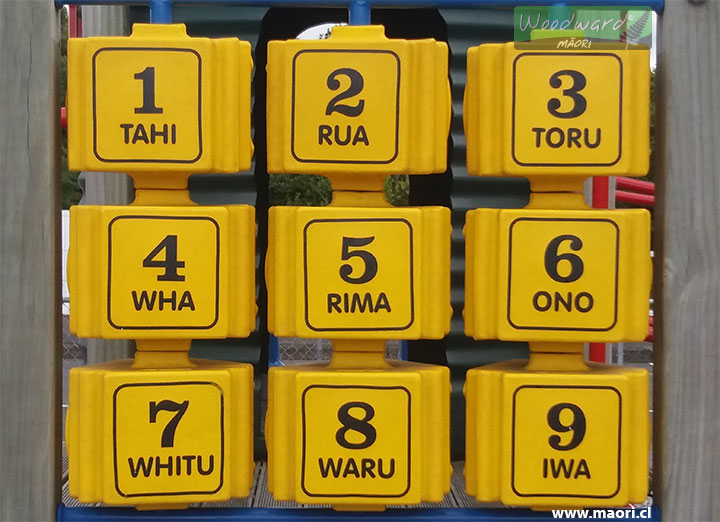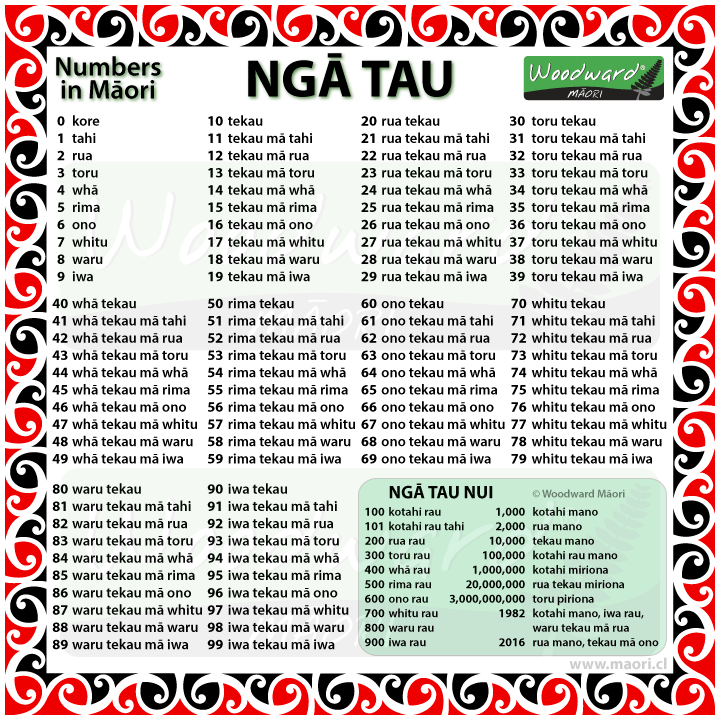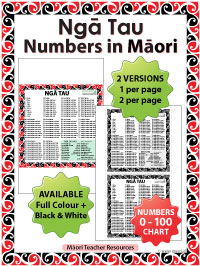Numbers in Māori - Ngā Tau
Māori Language
The numbers from 1-10 in Māori
Once you have learnt the basic ten numbers, it is very easy to count up to one hundred and beyond. These are numbers from 1 to 10 in Māori:
- 1 - tahi
- 2 - rua
- 3 - toru
- 4 - whā
- 5 - rima
- 6 - ono
- 7 - whitu
- 8 - waru
- 9 - iwa
- 10 - tekau

The photo of the numbers above are from a local playground in New Zealand
Large numbers in Māori
All numbers from 11 will now follow a basic pattern. For example to say twenty-two, simple say rua tekau, which means 20 and then mā rua, Rua tekau mā rua. So all you have to do is learn the numbers from 1 - 10 and then the words for 10, 20, 30, 40 and so on.
- 11 - tekau mā tahi
- 12 - tekau mā rua
- 13 - tekau mā toru
- 14 - tekau mā whā
- 15 - tekau mā rima
- 16 - tekau mā ono
- 17 - tekau mā whitu
- 18 - tekau mā waru
- 19 - tekau mā iwa
- 20 - rua tekau
- 21 - rua tekau mā tahi
- 22 - rua tekau mā rua
- 23 - rua tekau mā toru
- 30 - toru tekau
- 40 - whā tekau
- 50 - rima tekau
- 60 - ono tekau
- 70 - whitu tekau
- 80 - waru tekau
- 90 - iwa tekau
- 100 - kotahi rau
- 101 - kotahi rau tahi
- 111 - kotahi rau tekau mā tahi
- 200 - rua rau
- 234 - rua rau toru tekau mā whā
- 300 - toru rau
- 400 - whā rau
- 500 - rima rau
- 600 - ono rau
- 700 - whitu rau
- 800 - waru rau
- 900 - iwa rau
- 1000 - kotahi mano
- 1982 - kotahi mano, iwa rau, waru tekau mā rua
- 2000 - rua mano
- 2024 - rua mano, rua tekau mā whā
- 3000 - toru mano
- 4000 - whā mano
- 5000 - rima mano
- 6000 - ono mano
- 7000 - whitu mano
- 8000 - waru mano
- 9000 - iwa mano
- 10000 - tekau mano
- 1,000,000 - kotahi miriona
- 2,000,000 - rua miriona
- 3,000,000,000 - toru piriona
Summary Chart

We have a version of this maori numbers chart that can be used in the classroom here: Numbers 1-100 in Māori PDF
Counting in Māori
When counting things (not people) in Māori, you use E before that number (but not joined to it). It is similar to saying "There are".
- E whā ngā kuri
(There are) four dogs
Toko is added to the beginning of a number when counting less than 10 PEOPLE. It answers the question "How many people are there?" So Tokorua means there are two.
- Tokohia āu tamariki? Tokotoru
How many children do you have? Three
Kotahi is used when counting both ONE thing or ONE person.
- Kotahi te whare
(There is) one house.
NOTE: numbers higher than NINE do not have a prefix.
Look at examples of numbers with Toko and E in the following chart:
| 1 | tahi | Kotahi te manu | = one bird |
| 2 | rua | E rua ngā kuri | = two dogs |
| 3 | toru | E toru ngā ngeru | = three cats |
| 4 | whā | E whā ngā rākau | = four trees |
| 5 | rima | E rima ngā heihei | = five chickens |
| 6 | ono | Toko ono ngā tāngata | = six people |
| 7 | whitu | Toko whitu ngā kōtiro | = seven girls |
| 8 | waru | Toko waru ngā tama | = eight boys |
| 9 | iwa | Toko iwa ngā tamariki | = nine children |
| 10 | tekau | Tekau ngā hipi | = ten sheep |
How many...?
To ask how many (things) you say E hia...? But this rule is NOT used when counting people.
To ask how many people you say, Tokohia...?
Ordinal Numbers in Māori
Ordinal numbers are ones that show a position, ranking or level. In English they are the numbers that usually have -th after them (e.g. 5th, 19th). In Māori ordinal numbers are created by adding the prefix tua- to the number.
- 1st - tuatahi
- 2nd - tuarua
- 3rd - tuatoru
- 4th - tuawhā
- 5th - tuarima
- 6th - tuaono
- 7th - tuawhitu
- 8th - tuawaru
- 9th - tuaiwa
Ordinal numbers after the number nine do NOT have the prefix tua-.
Parent / Teacher Resource

If you found this guide about numbers and counting in Māori useful, let others know about it.
